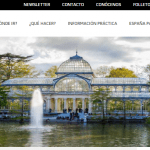Spain, via the Ministry of Economic Affairs and Digital Transformation and SEGITTUR, is to collaborate with the Inter-American Development Bank (IDB) to boost the Smart Destination model in Latin America and the Caribbean (LAC).
Spain has been a world pioneer in the development of the Smart Destination model, having received not only national, but also international recognition from important organisations such as the IDB, the World Tourism Organization, the World Travel and Tourism Council (WTTC) and the European Commission.
The IDB is the main source of funding for the development of Latin America and the Caribbean and it prioritises tourism as one of the main instruments for boosting economic growth, social inclusion and the environmental conservation of the region.
It has chosen SEGITTUR for its track record and experience, not just in the creation of the Smart Destination model and methodology, but also in its promotion of the Smart Destinations Network, which currently has over 250 members. The project is financed by the Ministry of Economic Affairs and Digital Transformation through the Spanish General Cooperation Fund.
The Smart Destination Model
The Smart Destination project was created with the objective of providing destinations with a tool with which to overcome the challenges of the sector, become more competitive and develop a tourism model which is sustainable in the long term.
Smart Destinations implement a world-leading methodology, focusing on incorporating innovation and new technologies into work processes, always based on the objectives of sustainability and accessibility, via a model of efficient, transparent and participatory tourism governance.
While developing a standardised framework, the Smart Destinations are also aligning with the smart cities creation process. In Spain, this has its own technical standard: UNE 178501, which also regulates the Smart Destination Management System. This is in addition to UNE 178502, which covers indicators and tools, and UNE 178503, which regulates semantics applied to tourism.
The Smart Destinations Network
Maximising the benefits the Smart Destination methodology brings to destinations is achieved through the Smart Destinations Network, a space for exchange and coordination, to share knowledge, generate synergies between destinations and develop strategic alliances between destinations and the private sector, reinforcing and providing continuity to the initiative.
The project, which is sponsored by the IDB via the Spanish General Cooperation Fund and which will extend into 2022, will boost the adoption of technology in LAC destinations, as well as governance focused on creating a regional Smart Destinations Network, taking into account the need to encourage public-private cooperation, reinforce destinations’ management capacities and generate a collaborative environment in which to exchange best practices and generate knowledge about the potential of technologies applied to tourism.
Smart Destinations in the LAC Region
The WTTC estimates that tourism represented 8.1% of the total Latin American GDP and 13.8% of the Caribbean GDP[1] in 2019. Tourism was also responsible for 7.9% of employment in Latin America and 13.5% in the Caribbean. However, the tremendous impact of COVID-19 on the tourism sector is being felt all around the world.
In this context, it is essential to consider the role that digital and emerging technologies can play in reactivating the sector and guaranteeing its future profitability, reinforcing not only health security in the destinations, but also their adaptation to climate change and socio-environmental sustainability.
In this sense, the project is relevant and timely as it will use instruments for technological diagnosis and knowledge sharing and will develop technological pre-investment plans and designs for innovative projects that will accelerate the adoption of digital and emerging technologies by LAC tourist destinations.
1 – including indirect and secondary effects.





